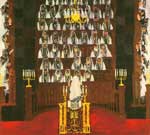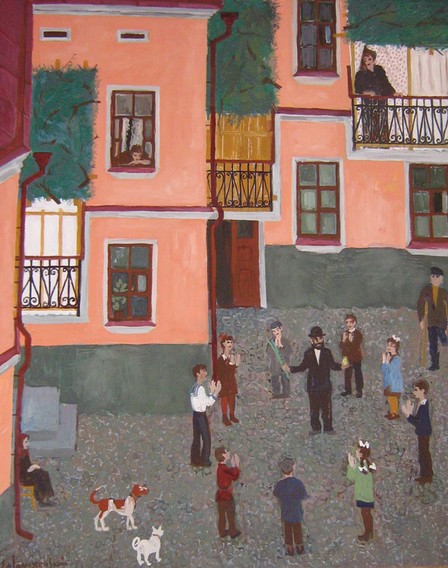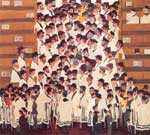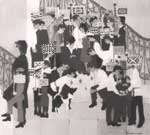 |
"Synagogue". Private collection, USA

I was painting the canvas "Synagogue" and thinking about the volume of years forming a chasm between my present self and that boy from house number 100 on Market Street, Odessa.
That boy, Fima, knew his routine, but how actively did he take part in the festive commotion, feeling almost physically the excitement of approaching holidays! Most
|
 |
probably he didn't know what events from the Jewish history were celebrated by these holidays. It was not the history he felt but himself – in "Sukkot", "Simches-Toire", "Chanukka", "Purim" and "Pesach".
He didn't know what symbolised the sound extracted from the horn in the synagogue, but he was sure it was a sound of triumph. Holidays which began with the beautiful, loud peel of bells coming from the nearby Uspensky church, caused a kind of alarm, maybe curiosity, but never inspired in him the lightness of body and |
 |
| |
|
|
|
|
 |
spirit that were brought by the Jewish holidays. All the holidays, lit up and warmed by the sun, are entangled in my memory like a ball of wool. It seems to me that in those days were was never a day of bad weather, no matter the season.
There were many synagogues in Odessa, maybe even more than churches. The synagogues were identified with certain professions. In Uspensky Lane there was the synagogue of butchers and market-women selling kosher poultry; the synagogue at the Meshchansky – Bolshaya Arnautskaya junction belonged to the
|
 |
shoemakers and footwear wholesalers; the synagogue at the corner of my street to fishmongers. Here my Papa had a permanent seat in the middle of the third row, and my Mama a seat on the balcony behind the curtain, close to the balustrade. I used to run upstairs to my Mama for her support and caress. "Oh Fimenyu, you must be more polite, don't disturb people at prayer".
People were carried away in their prayers towards an unknown future, weeping to the sound of the cantor's chanting . The better the cantor sang and the higher his notes reached, the more |
 |
| |
|
|
|
|
 |
he managed to take the parishioners away from the mundane, filling them with hope. This was a genuine artistic performance.
In the Brodsky synagogue they had an organ accompanying the choir, here the cream of the city prayed.
The Shalashnaya synagogue was shelled from a French warship leaving Odessa, and one of the shells set it on fire. The Jewish mobsters rushed to save the Torah scrolls, hoping this would cleanse their consciences from both former and future raids.
On Sukkoth* the balconies resembled
|
 |
swallow nests attached to the walls. The top of the "sukkah-balcony" was covered with palm branches brought from Palestine.
* Sukkoth – Jewish autumn holiday
"Sukkoth". Private collection, Israel

Shortly before the holiday a ship from Jaffa came to our port, its hold full of palm branches, |
 |
| |
|
|
|
|
 |
lemons and raisins. My Papa wrapped in his "tales"* prayed standing near the eastward window, with a palm branch in one hand and a lemon in the other.
"Simchat Torah". Private collection, London

I remember Torah scrolls carried out on "Simches Toire"**, the curtains of |
 |
red velvet finished with golden fringe and tassels. Two lions held up the crown with their front paws. Weaved with gold thread they sparkled in the light of candles and blazing sun rays that penetrated through the coloured window panes of the synagogue. When the curtain was drawn apart, the Torah scrolls in coloured ‘outfits' were revealed as if on a theatre stage.
Men shrouded in “tales” took their precious load, kissed it and passed it around along the aisles between the benches.
The racket at these moments was horrendous – the banging of folding
|
 |
| |
|
|
|
|
 |
wooden seats; the wheezing of the old Jews hastening to the aisles to touch the bright Torah outfits with their lips; the sound of loud prayers in ancient Hebrew.
Everyone was uplifted, the wicked became “kind”, the kind became kinder, the asthmatics breathed more easily, and those in good health breathed quicker.
We, the children, were lifted up to kiss the scrolls, and I, a fastidious little boy, imperceptibly pecked my fingers instead. This is how I remember this almost carnival holiday.
* tales – traditional undergarment worn by
|
 |
religious Jewish men
**Simches Toire – Jewish autumn holiday celebrating God presenting the the old testament to Moses
"Chanukka". Private collection, London

Shortly before "Chanukka" *, the markets, street corners and yards got filled with small flags for sale. These were double-sided |
 |
| |
|
|
|
|
 |
flags wreathed from colourful glossy paper stripes resembling small rugs 25-30 centimetres long and glued to a stick, with a distinct geometrical, ornamental pattern on them. The lower part of the stick was wrapped round with paper fringe, and the upper part jutted out above the flag. This was used to fix the apple on the stick with a thin candle fixed on top. For this purpose, bright red “gypsy” apples were chosen.
Spinning tops moulded from lead were bought for us children, with four sides and a prominent nail in the middle. We grasped |
 |
them between three fingertips and made them spin on smooth table or floor surfaces. Each side had a Hebrew letter on it, and when the fidget fell on the letter you chose, you received a few nuts as a prize.
“Purim” is the sweetest, tastiest of all the holidays. The dough for the “homen-tash”* pastry was self-willed and capricious. It irritated my Mama by escaping from the enamel saucepan covered with snow-white cloth, while at the same time delighting with its splendid rise.
And the “shtrudel”? Oh, these long pastries with a mahogany crust, with
|
 |
| |
|
|
|
|
 |
knife marks on it, on a black baking tray, omitting fragrant clouds of marvelous vanilla and cinnamon scent. Nuts, raisins, jam and liquor cherries hidden in the crispy flaky pastry – all these were creations of primeval sweet lovers.
Ambitious housewives, neighbours and acquaintances, exchanged plates with their hand-made creations, “sholokh-moones”* wrapped in bluish, starched napkins.
On each Jewish holiday some form of poultry – a chicken, a goose, or a duck - were the main dish.
Once, in the thirties, I visited my Mama during my summer holiday. Soon a
|
 |
duck was bought on the Privoz market. When it was let out of the basket, it turned out it was lame. I begged for it not to be taken to the butcher. Favouring one leg, it was wandering around the apartment and on the balcony, pecking corn seeds. It seemed that the duck appreciated my role in its destiny and kept following on my heels when I was returning home from my sketching lessons.
* Chanukka – Jewish winter holiday celebrating the miracle of a small oil lamp burning for seven days and which allowed the rebuilding of the second Jewish temple on
|
 |
| |
|
|
|
|
 |
the Mount
** homen-tash (Hamman's ear) – traditional Purim sweet of triangular shape, with different flavoured fillings
*** sholokh-moones – gifts or pocket money given to children as part of Purim celebrations
Fragment of the canvas "We Received Matza".
Private collection, London

Pesach* was distinguished |
 |
by matzo** and the extremely solemn preparations associated with this holiday.
This was a time of renewal. The everyday curtains were replaced with lacy ones, with fanciful floral designs. The table set, and the tea-service produced at the famous Kuznetzov porcelain factory were taken out of the sideboard. Year after year, their wonderful patterns in a colour of fresh hay and the glitter of their golden edging produced an indelible impression. Washed in the basin and dried with a new dishcloth, they were arranged on the extended
|
 |
| |
|
|
|
|
 |
table, making a tinkling sound which hung in the air when they accidentally knocked against each other.
Any metallic appliances for cooking, roasting, frying, broiling, or grilling were cleaned from a year's worth of ‘kosher' patina.
A porter delivered matzo in light wicker baskets covered with warm bed-sheets, bearing them for some incomprehensible reason on his head.
My first seder*** was engraved in my memory by Sirkis soap, with which we were lathered, while bathed on the eve of the first day of Pesach; the moon outside the window
|
 |
insisting on a place at the festive pesach table; the term "sykoires" meaning something bitter in a porcelain dish; ladies' bonnets, caps and hats worn at the dinner table only once a year; the goblet standing on the edge of the festive table, before the open front door, to let Prophet Elias enter our house and take a sip of wine. Often we stared at the goblet for minutes on end, until under our intense gaze it seemed that the level of wine went down, and that Elias probably had already visited us, and we could therefore close the door.
The Seder questions were asked by my younger
|
 |
| |
|
|
|
|
 |
brother, while I only wondered, ‘how could Ilya ha-Nuvi**** drink wine in each Jewish family in Odessa?' Any time now he was going to get so drunk that he wouldn't be able to reach his heavenly bed .
It's morning. The sun had replaced the moon, my Papa went to the synagogue, and we, accompanied by the hissing sounds of the samovar+, were drinking our morning tea with delicious fried matzo pasties Mama had put on the white pesach table-cloth.
* Pesach – Passover. Jewish spring holiday celebrating the Jewish exodus from Egypt
|
 |
** matzo – unleavened Jewish flat bread eaten during the Passover main ritual meal.
*** seder – the Passover main ritual meal
**** Ilya ha-Nuvi – another name for the prophet Elias
+samovar – Russian traditional brass container for boiling water used for making tea.
Yefim Ladizhinsky
|
 |
| |
|
|
|
|
| |
|
|
|
|
| |
|
|
|
|
|
|
|
